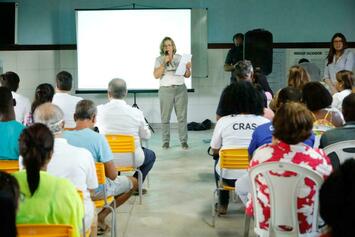2023 Award "Best Practice in Citizen Participation"
17th Edition
Salvador Neighborhood Plans
The Neighborhood Plan as a methodology was initiated in 2020 by request of the Social Work of Sister Dulce, a local religious organization, to the Salvador City Hall, through the Fundação Mário Leal Ferreira (FMLF). The request was to support the Holy Territory project, whose objective was to encourage religious tourism in the Itapagipe peninsula as a way to improve the conditions of the territory to receive pilgrims.
The peninsula is part of the city and comprises 14 neighborhoods, where 164,264 inhabitants live (CENSUS 2010), having its history defined by the city's own history and by the faith in three saints: Saint Dulce de los Pobres, Saint John Paul II and Mother Teresa of Calcutta. It also highlights the pilgrimage to the Church of Senhor do Bomfim, the largest ecumenical devotion of Salvador (Catholic and Candomblé). It was the location of the city's former garbage dump, an area of the city known as Alagados, which was transferred in the 1980s to the Canabrava neighborhood, but is still mostly occupied today by vulnerable population.
Thus, the FMLF decided to elaborate an urban diagnosis that showed that the needs of the territory required a multisectoral, transdisciplinary approach and a broad participatory process involving leaders, local organizations, universities and other municipal departments.
At the same time, FMLF technicians elaborated the diagnosis of the peninsula to initiate the collective construction, carried out in virtual workshops and with a broader public consultation. At that time, Covid 19's health crisis prevented face-to-face meetings.
All the technical content produced was submitted to the appreciation, complementation and validation of the participants and the planning was built in a participatory manner, generating thematic maps with proposed actions, goals and execution deadlines. As emergency actions were identified, they were prioritized.
Based on this experience, the Ilha de Maré Neighborhood Plan was subsequently developed and the Canabrava Plan is currently being finalized. Another plan is scheduled to be launched in 2023.
The three plans mentioned above cover 16 neighborhoods in which 182,164 people live, or 7% of Salvador's population.
The second plan, for the island of Maré, was concluded in 2023. Being one of the city's islands, it has 4,326 residents in 12 communities. It is a quilombola territory, with 4 of the 5 quilombos recognized by the Palmares Foundation in Salvador, and presents problems of internal mobility and connection with the mainland.
The third plan is scheduled for completion in August of this year, and is serving as the basis for defining the international support of the Gap Fund in Salvador. This is a neighborhood of 13,664 inhabitants, located in the center of the city and formed after the relocation of the Alagados landfill, by the landfill's waste pickers.
The methodology is being developed and refined as new plans are developed. The assessment is scheduled to take place in 2 years, 4 years and 8 years after publication.
The first assessment, that of Itapagipe, is scheduled for 2024, which will undoubtedly contribute to planning.
Site da Fundação: https://fmlf.salvador.ba.gov.br/
Plano de Bairro de Itapagipe: http://biblioteca.fmlf.salvador.ba.gov.br/phl82/pdf/livros/Plano_Itapagipe.pdf
Plano de Bairro de Ilha de Maré: http://biblioteca.fmlf.salvador.ba.gov.br/phl82/pdf/livros/Plano_Ilha_Mare.pdf
Documentação completa do Plano da Ilha de Maré: https://fmlf.salvador.ba.gov.br/plano-da-ilha-de-mare/
Documentação completa do Plano de Canabrava: https://fmlf.salvador.ba.gov.br/plano-de-bairro-de-canabrava/
Report inappropriate content
Is this content inappropriate?





3 comments
Loading comments ...
Add your comment
Sign in with your account or sign up to add your comment.
Loading comments ...